Company Spotlight: Protolaunch
Marketing

Back in the 1960s, NASA’s Apollo Moon landing demonstrated the capability behind propulsion and how throttleable propulsion can allow us to travel beyond Earth and land on the Moon. Humanity has since delivered rovers to Mars, delivered spacecraft into deep space and this year even achieved soft landing in the Southern Polar region of the Moon. Without the innovative space sector, we would still be limited to terrestrial networks, technology without GPS capability and space exploration only through telescopes fixed on Earth.
Propulsion plays a pivotal part in ensuring a spacecraft gets to where it is intended to go and keeps it on its planned trajectory. The purpose of in-space propulsion is to change the velocity of a spacecraft. Thrust in space can therefore be achieved either through a small acceleration over a long period of time, or a large amount of acceleration over a short timeframe. When launching from a planet, a propulsion method must overcome a higher gravitational pull to provide acceleration to the craft. Tiny accelerations will not be greater than the natural forces of the planet’s gravitational pull. However, in the vacuum of space, precision accelerations become paramount to ensure a spacecraft is positioned correctly. Propulsion technology is broadly subdivided into groups based upon the physics of the propulsion and the way it derives thrust. These are often described as chemical, electric and nuclear propulsion.
Historically an airfield for the Royal Air Force during the Second World War, the Westcott site based in Buckinghamshire has seen significant change over the years – Westcott’s historic timeline. In 1995, Wescott became a private business venture park. Today there are around 80 tenant companies on site. The area remains a hub for space-based research and development organisations and in 2018 Wescott Space Cluster was established. Alongside was the creation of the Future Networks Development Centre, Innovation Centre and Incubation Centre. Through the Catapult network, the centres provide a springboard for business development and academic research in emerging high growth markets. One of the propulsion companies at Wescott is Protolaunch.
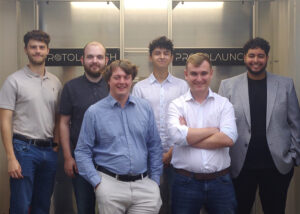
Matt Escott, CEO, and co-founder of Protolaunch graduated from a master’s degree in engineering at the University of Cambridge, and along with fellow co-founder Dr Jack Coghen-Brewster established Protolaunch in 2019. The company joined the Westcott Business Incubation Centre early on in its conception and have since been developing in-space rocket engines from its propulsion test site at Westcott Venture Park. The company actively collaborates with other companies in the space industry, recognising the importance of collective expertise. In the first 12 months as a business, Protolaunch gained experience through the Westcott Incubator and Accelerator programme (WIA), identifying that the evolution of the space industry hinges on developing a profound understanding of market demands.
“Protolaunch has played an active role in the UK space propulsion industry since 2019, acting as chemical propulsion specialists while re-investing in our state-of-the-art propulsion test facility at Westcott Venture Park” – Matt Escott, Protolaunch Ltd CoFounder & CEO
Protolaunch’s approach to propulsion goes beyond just technical innovation. Matt currently helps to chair the UK Space Propulsion Working Group (SPWG) – a body of industry, academia and government. The working group’s purpose is to increase the UK’s competitiveness in delivering space propulsion systems globally. One recent initiative from the SPWG was UK Race to Space, a national educational rocketry competition led by Alistair John, Deputy Director of Aerospace at the University of Sheffield. Matt highlights how numerous Protolaunch staff members have fond memories of taking part in student rocketry competitions when they were younger. Keen to help, Protolaunch provided its facility and expertise. This enabled practical experiments for students to take place, bridging the gap between theory and practice by testing of the students’ own rocket designs.
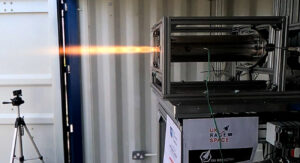
Image Credit: Protolaunch – Rocket engine developed by students at Glasgow University, tested at the Protolaunch Propulsion Test Facility as part of the Race to Space 2023 competition.
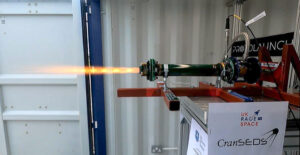
Image Credit: Protolaunch – Rocket engine developed by students at Cranfield University, tested at the Protolaunch Propulsion Test Facility as part of the Race to Space 2023 competition.
In 2020, Protolaunch successfully ran a hot-fire programme for its HILBERT thruster. Developed to produce up to 10kN of throttleable thrust, the platform blended both traditional and additive manufacturing techniques. Having on-site metal additive manufacturing facilities, such as the Westcott Space Cluster’s MetalFAB facility, allows companies such as Protolaunch the ability to rapidly prototype multiple design options while maintaining a low cost of production. This additive manufacturing capability allows for the creation of more complex parts at a reasonable price, whilst also reducing waste.
HILBERT thruster at Westcott test site
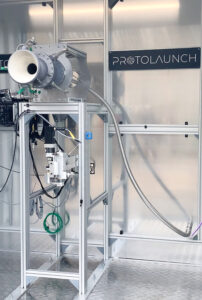

Image credit: Protolaunch.
Over the last decade we have seen exponential growth of small satellite launches. A decrease in the cost of launch has enabled a new revolution of Low Earth Orbit (LEO) satellite constellations. Over 18,500 Smallsats are forecast to be launched between 2022 and 2031, 81% of which are expected to be part of constellations. In-orbit propulsion will continue to play a pivotal role, as will satellite sustainability. As large satellite constellations continue to grow, providing enhanced coverage and capabilities, we are likely to see a focus on sustainability in space. These sustainable solutions will not only provide longevity for recently launched satellites, but also provide brand new options in the deorbit of legacy and new satellites. A fundamental aspect of this evolution relies on precision propulsion systems.
Matt remarks: “If you look at some of the products we were developing years ago versus the products we have developed now, they are very different.” Matt adds: “This has all come about from how we have seen the market demands for in-space propulsion change. IOSM is widely acknowledged to be a transformative sector and a key driver of the emerging in-space economy. We have heard repeatedly from customers how In-Orbit Servicing and Manufacturing and Rendezvous and Proximity Operations have very different propulsion challenges compared to legacy platforms. Our FOx-1 and Arctic FOx products are designed from the ground up to address this gap in the propulsion market and capitalise on these rapidly growing market segments in LEO. It’s not just about being a bit more efficient than thrusters on the market today, but instead, developing systems specifically designed for a niche that simply didn’t exist five years ago.”
Hydrazine has previously dominated the propulsion market despite being extremely toxic. Greener fuel alternatives now being utilised reduce the significant associated health risks drastically and mean for the first time ever these systems are safe to return-to-Earth – a key enabler for in-space manufacturing business models. From a commercial standpoint, seeking better and safer fuel whilst decreasing reliance on dangerous chemicals results in other benefits such as cheaper insurance and lower handling costs at the launch site.
Matt indicates that while pioneering propulsion technology remains important, it must harmonise with the real-world needs of the market. “As the in-space economy develops we’re getting closer to having space to be a place to do business rather than just to explore. That has brought with it new sorts of mobility challenges. Suddenly, you’ve got very big platforms operating in LEO rather than geostationary orbit (GEO) and that needs a very different kind of propulsion system. When these large platforms were located entirely in GEO, graveyard orbits for end-of-life disposal were possible. By deploying these platforms in LEO, end-of-life disposal and de-orbit or return-to-Earth is a much more pressing concern”.
“As space continues to get more crowded and new business models emerge that require de-orbit or return-to-Earth, new technologies are needed. By using oxygen and hydrogen as our propellant, the gaseous components of water, Protolaunch is able to offer a safer and more sustainable alternative to the toxic propellants that dominate today’s market without sacrificing performance. As we bring our FOx products to market, we hope to make propulsion a commodity item in spacecraft design and enable new reusable and return-to-Earth mission architectures as space continues to become an ever-growing part of people’s day-to-day lives.” – Dr. Jack Coghen-Brewster, Protolaunch CoFounder & CTO.
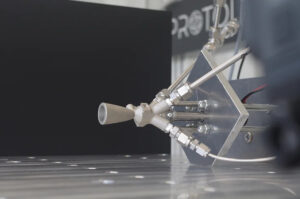
A FOx-1 Thruster mounted on the test bench for hot-fire testing at the Protolaunch Propulsion Test Facility – Image credit Protolaunch
From the outset, development of the FOx-1 and Artic Fox thrusters have had a specific focus on the propulsion demands of IOSM customers. In response to the assessed sector requirement, Protolaunch has developed and accelerated its thruster designs in the form of its flagship product the FOx-1 (pictured above). Matt indicates the target market for the FOx products as “New in space economy driven markets. So that’s in-space manufacturing, in-orbit servicing… Things that need to be hyper-mobile and have unusual demands.”
Protolaunch’s FOx-1 is a small 20 newton thruster able to precisely deorbit satellites. Addressing sustainability in space, the thruster utilises very clean fuels. Matt adds how its rocket propellant will also depend on the customer: “Gaseous Oxygen (GOX) and hydrogen, or methane as the fuel and GOX as the oxidizer depends on customer requirements. Oxygen and hydrogen have the highest possible chemical performance, but hydrogen has certain challenges. So, for some applications, oxygen and hydrogen is best for ultimate performance and the ability to derive propellant from water. For some more immediate applications it’s better to substitute methane for now, as it is easier to store, with the view to going towards hydrogen in the future”.
There certainly is interest from the European Space Agency and NASA in revisiting the Moon (Artemis III). Throttleable landing technology would certainly feature in this. There is also the future potential of oxygen and hydrogen based propellants being processed though in-situ lunar regolith production. However, Matt indicates that right now, the first commercial market Protolaunch is focused on will not need continuous throttling capability. For Protolaunch’s customers, the FOx- 1 thruster provides a dual-mode operation able to operate at two distinct fixed thrust levels. For in-orbit serving applications, the requirement is targeting hyper-mobile spacecraft. This is due to new requirements to have spacecraft interacting with an increased degree of mobility. Most FOx-1 customers will therefore require multiple thrusters in fixed positions, although this can vary from customer to customer.
“The most common configuration will be several FOx-1s in fixed positions with differing angles so a combination can be fired to create different torques for the spacecraft. There are also some applications that could just have one thruster being actively pointed through a Thrust Vectoring Control System (TVC). To do it this way is ultimately more complicated, and because our FOx-1 system isn’t that expensive, it can often be easier to have more of them” Matt comments.
With an orbit demonstration expected in 2024, Protolaunch remains committed to driving innovation and advancing the frontiers of commercial space operations. Through its end-to-end approach of design, manufacture and testing, Protolaunch simplifies what can often be a more laborious process. The fact Protolaunch has its own test site and does not require ongoing involvement of any other party to iterate on proposed rocket engine designs, means it epitomises a fast-moving dynamic company. Not only that, but due to having this capability as a company ‘in house’ it can bid on a wide range of contracts and partner with other innovative companies, opening its facility where needed.
Protolaunch recognises the need for versatile propulsion systems that can cater to the variety of new in-space servicing markets. For instance, most thrusters on the market right now use liquid propellant, which usually allows for the volume of the propellant tank to be relatively low, but conversely provides additional problems within zero gravity environments attributed with the fuel tank centre of mass changing as it burns through fuel. Matt explains that “Manoeuvres with liquid propellant present ‘sloshing’. Essentially in a liquid propellant system you’ve got to control all these vibrations or wait until the sloshing subsides before turning your thruster back on. With our gaseous approach we have provided a simplified solution to this challenge. By utilising a gaseous system such as the FOx-1 you don’t have these ‘sloshing’ concerns, it is more responsive, providing increased mobility. The other huge benefit is having a system where the centre of mass doesn’t change during longer burns; a significant challenge when using liquid thrusters in deorbiting situations”.
Protolaunch recently achieved a significant milestone in the successful closure of its initial investment round. Matt attributes this to locking in on the specific niche of IOSM in space propulsion, adding that this has led to building the most convincing argument for a real and immediate market demand.




